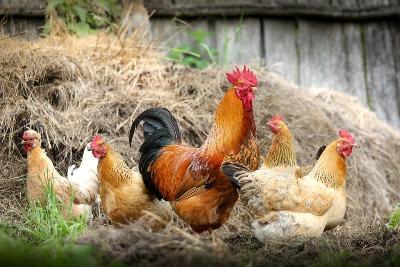NEW DELHI, 02 September 2017 : Misuse of antibiotics in poultry farms is leading to a proliferation of multi-drug resistant bacteria.
To make matters worse, these bacteria are now spreading in the environment because of unsafe disposal of poultry litter and waste in agricultural fields–this has a potential to infect human beings: says a new study from Centre for Science and Environment (CSE).
The study – titled ‘Antibiotic Resistance in Poultry Environment’ – conducted by CSE’s Pollution Monitoring Laboratory, collected samples of litter and soil from in and around 12 randomly selected poultry farms. These were located in four key poultry-producing states in north India – Uttar Pradesh, Haryana, Rajasthan and Punjab.
A total of 217 isolates of three types of bacteria – E.coli, Klebsiellapneumoniae and Staphylococcus lentus– were extracted and tested for resistance against 16 antibiotics. Ten of these antibiotics have been declared Critically Important (CI) for humans by the World Health Organization (WHO).
The poultry farms identified by CSE for this study are spread out across 12 different clusters in nine districts. CSE researchers found that antibiotics were being used in these poultry farms, and that the litter was used as manure in neighboring agricultural lands.
As a control, the study also collected 12 soil samples at a distance of 10 to 20 kilometers from the respective farms, where the litter was not being used as manure.
Releasing the findings of the CSE study here today, Chandra Bhushan, deputy director general, CSE, said: “Antibiotic misuse is common in the poultry sector. What makes the situation worse is the fact that the sector is also plagued with poor waste management. Therefore we first wanted to understand the extent of antibiotic resistance in the poultry environment, and then establish if the resistance bacteria is moving out of the poultry farms into the environment through waste disposal.”
Poultry environment – reservoir of multi-drug resistant bacteria
If anybacteria are resistant to antibiotics of at least three classes, they are considered as multi-drug resistant. The study found that 100 per cent of the E. coli, 92 per cent of Klebsiellapneumoniae and 78 per cent of Staphylococcus lentus isolated from the poultry environment were multi-drug resistant. About 40 percent of E.coli and 30 percent of Klebsiellapneumoniae isolates were resistant to at least 10 out of 13 antibiotics against which these bacteria were tested for resistance. Also, both E. coli and Klebsiellapneumoniae had very high resistance to antibiotics of critical importance to humans such as penicillins, fluoroquinolones, third and fourth generation cephalosporins and carbapenems, which is a last resort antibiotic used in hospitals.
“In humans, E.coli and Klebsiellapneumoniae cause infections which are becoming difficult to treat due to high resistance. Disturbingly, we found very high resistance in E. coli and Klebsiellapneumoniae isolates from the poultry environment. In some of the isolates, all antibiotics that we tested were ineffective. If these bacteria infect a human, then hardly any medicine will work as cure,” Bhushan said.
Spread of resistance from farm to fields
The study found strong similarity in the resistance pattern of E. coli from the litter and from agricultural soil in the surrounding areas where the litter was used as manure. This similarity was statistically established by the study.
“This indicates that the multi-drug resistant E. coli being created in the poultry farms is entering the environment through litter. From the agricultural fields, these bacteria can go anywhere – into groundwater and food – and can infect agricultural workers and animals, there by becoming a public health threat,” Amit Khurana, senior programme manager, food safety and toxins team, CSE said.
The study did not find any such similarity in the resistance pattern of Klebsiellapneumoniae and Staphylococcus lentus from litter and agricultural soil. It also did not find such similarity in the resistance pattern between the control samples and the study samples.
Bhushan points out that this aspect needs further research: “Our findings on E.coli clearly establish that resistance is moving out of farms to fields through litter. More studies are required to understand the behavior of the other two bacteria. The study also suggests that untreated litter was being used in agricultural fields. Clearly, India needs an antibiotic resistance-centric approach to waste management from poultry farms. Central and State Pollution Control Boards must take a lead role in this.”
The CSE study recommends controlling rampant antibiotic misuse as the most effective step to contain spread of resistance from farms. Further, it recommends that the Ministry of Environment, Forests and Climate Change along with Central and State Pollution Control Boards should play a greater role by enacting necessary laws and standards as well as ensuring regular monitoring and surveillance.
“There should be complete prohibition of disposal of untreated litter into the fields and use of litter as feed in aquaculture. Less risky manure management options – such as bio-gas generation-- should be promoted. Composting should only be done if other options are not available. This too should be done under a high degree of supervision, supported by adequate laws on site approval and process validation,” Khurana said.
“We now have a National Action Plan (NAP) on Antibiotic Resistance. The NAP addresses the issue of misuse of antibiotics in poultry farms as well restricting the spread of resistance in the environment. The NAP must be properly supported and funded by the Union government. The bottom-line is that we must eliminate the use of antibiotics as growth promoter in the poultry industry. Antibiotics should be used as a last resort to control the disease. This is the only way we can reduce the creation and spread of antibiotics resistance,” Bhushan said.




















